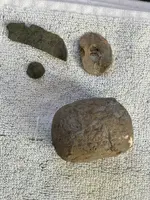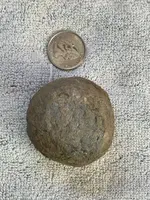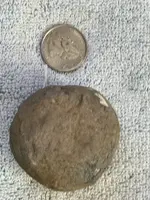When a cannonball is made of lead, it tends to consist of molten metal cast in a spherical mold. The corroded surface in of the metal in the photos does not have the appearance of cast lead. For example, lead does not develop cracks -- which we see in many places on this object's surface. Also, the object's shape is not anything close to a sphere. A cannonball MUST be a "True Sphere" because any significant lumps of bumps or out-of-roundness will cause the ball to "jam" in the cannon's bore during loading or firing. Also, this object does not look like a cast lead True-Sphere which has taken a few bumps from bouncing across the ground after firing. Sorry, I do not know what it is but I'm reasonably sure about what it's not -- a cannonball, a grapeshot ball, or other Artillery ball.
I should mention:
American Military cannonballs and e ball were always made of pure lead. This object appears to some sort of "pot-metal" type of cheap lead-alloy.






